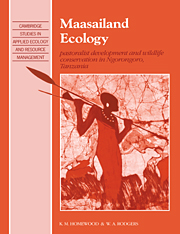Book contents
- Frontmatter
- Contents
- Preface
- 1 Management problems and applied ecology in Ngorongoro Conservation Area
- 2 Ngorongoro Conservation Area
- 3 Maasai of Ngorongoro
- 4 History, politics and perceptions in Ngorongoro
- 5 Management-oriented research in NCA
- 6 Range resources
- 7 Wildlife
- 8 Livestock ecology
- 9 Livestock and wildlife
- 10 Maasai ecology: development, demography and subsistence
- 11 Wildlife conservation and pastoralist development
- 12 Development interventions
- 13 Viewpoint
- References
- Author index
- Subject index
- Map: Ngorongoro Conservation Area, showing the main features and place names used in the text
12 - Development interventions
Published online by Cambridge University Press: 08 February 2010
- Frontmatter
- Contents
- Preface
- 1 Management problems and applied ecology in Ngorongoro Conservation Area
- 2 Ngorongoro Conservation Area
- 3 Maasai of Ngorongoro
- 4 History, politics and perceptions in Ngorongoro
- 5 Management-oriented research in NCA
- 6 Range resources
- 7 Wildlife
- 8 Livestock ecology
- 9 Livestock and wildlife
- 10 Maasai ecology: development, demography and subsistence
- 11 Wildlife conservation and pastoralist development
- 12 Development interventions
- 13 Viewpoint
- References
- Author index
- Subject index
- Map: Ngorongoro Conservation Area, showing the main features and place names used in the text
Summary
Murua rraga mimanya Stay uninhabited
(Maasai wish or blessing, spoken to the landscape: Kipury 1983)Given that any lasting development in the pastoralist system is likely to be towards a more secure subsistence rather than towards intensive commercial production, could technical inputs make a useful contribution that is also compatible with conservation? Our study of livestock performance suggested that NCA livestock mortality and fertility rates as well as milk production are average for subsistence pastoralism. Declining exchange rates of stock for grain, deteriorating conditions of transport and grain supply, together with the general ecological good health of the NCA, suggest that subsistence problems arise more as a result of the lack of access to grain, the growing population and the adverse market conditions than from any inherent inefficiency in NCA Maasai livestock production. However, it might be possible to solve some of the problems of pastoral subsistence in NCA by improving husbandry and introducing technical interventions. Even if livestock development for intensive commercial offtake is unlikely, development interventions might make Maasai pastoralist subsistence more viable within the constraints of conservation requirements and policies. Are there aspects of management of water resources, range, grazing, breeding control, breed improvement, disease management, or marketing of milk, animals and other produce that could be improved while remaining compatible with conservation? In this chapter potential technical and administrative interventions are examined insofar as they affect Maasai subsistence ecology, and the wildlife and other conservation values of NCA.
- Type
- Chapter
- Information
- Maasailand EcologyPastoralist Development and Wildlife Conservation in Ngorongoro, Tanzania, pp. 249 - 264Publisher: Cambridge University PressPrint publication year: 1991



